December 21. GANGTOK (SIKKIM) "Visiting Rumtek" The Rumtek Dharma Chakra Center stood on the other side of the valley from Gangtok which, in Himalayan terms, wasn't that close. Going down the steep side of one hill and up the steep side of another amounted to 26km to just "get across the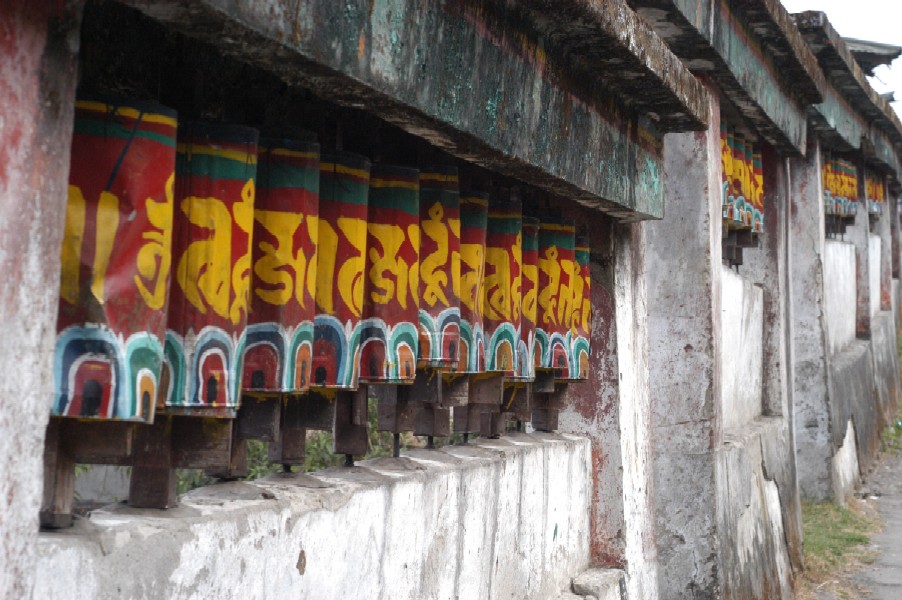 valley". We hired a taxi for the day because local transport was less frequent in the afternoons and we didn't want to get stranded at Rumtek for the night. It took about an hour to make the 26km journey. Our driver tried to be quick about it but the little van was less solid than a jeep when it navigated the turns and we were too tall to see out of the windows without crouching so I was feeling somewhat queasy by the time we arrived at Rumtek. The weather was overcast but not too cold and it felt refreshing to just be out of the van. valley". We hired a taxi for the day because local transport was less frequent in the afternoons and we didn't want to get stranded at Rumtek for the night. It took about an hour to make the 26km journey. Our driver tried to be quick about it but the little van was less solid than a jeep when it navigated the turns and we were too tall to see out of the windows without crouching so I was feeling somewhat queasy by the time we arrived at Rumtek. The weather was overcast but not too cold and it felt refreshing to just be out of the van.
At the driveway we had to hand our passports over to be recorded by a security guard before we were allowed to proceed up to the monastery. We weren't the only tourists that day. A group of three American women entered just ahead of us. The long driveway passed a long row of prayer wheels and some small shops as we went up the hill. The monastery was built in the 1960's by the 16th Karmapa Lama and was modeled after the original seat of the Karmapa Lama in Tibet, Tsurpu Monastery (Tsurpu was originally destroyed by the Chinese but has been re-built). So, the Rumtek building doesn't hold as much historical importance but it is very important as the present seat of the Karmapa Lama, the head of the Kagyu sect of Tibetan Buddhism. 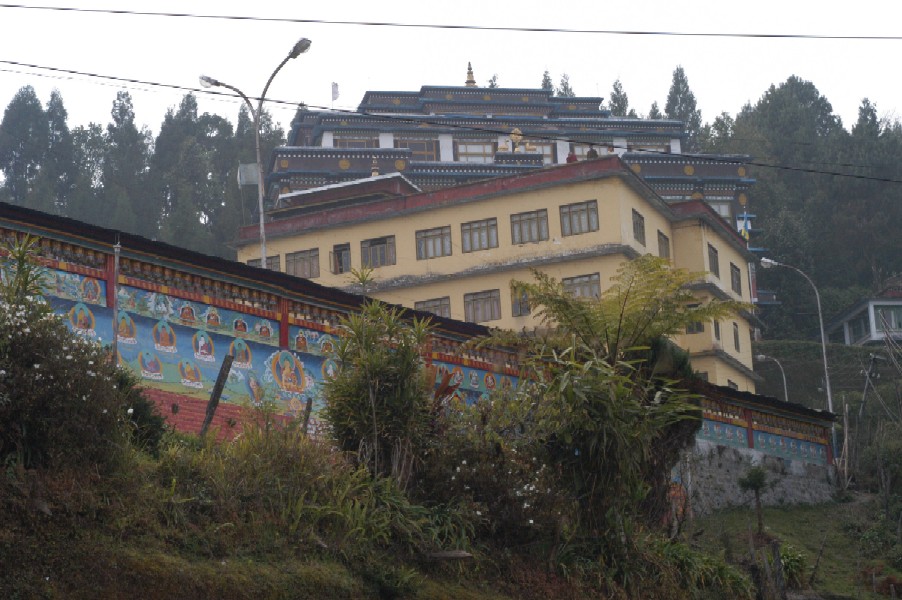 Today the Karmapa Lama, the third most important lama after the Dalai Lama and the Panchen Lama, doesn't reside at Rumtek because the Indian government won't give him permission to enter the region. It is a terribly complicated and unfortunate problem. In fact, the identity of the real Karmapa Lama is still open to some debate. In searching for the reincarnation of the 16th Karmapa Lama there was a split between two senior lamas at Rumtek. One lama supported Ogyen Trinley Dorje while the other lama supported Thagye Dorjee, both boys found living in Tibet. Ogyen was initially backed by the Chinese government in hopes that they could make a puppet governor out of him for Tibet but he fled and sought refuge with the Dalai Lama in Dharamsala, India. The other Karmapa, Thagye, now lives in exile in France and maintains that he is the real incarnation but the Dalai Lama has since recognized Ogyen as the Karmapa Lama. With the problem resolved the Sikkemese expected their lama to come to Rumtek but the Indian government has prevented that out of fear that he could be a spy for the Chinese. It is a particularly sticky issue since China doesn't recognize Sikkim as part of India and Ogyen did spend time under the influence of the Chinese government and was forced to make certain controversial statements. The Indian government initially banned Ogyen from relocatin Today the Karmapa Lama, the third most important lama after the Dalai Lama and the Panchen Lama, doesn't reside at Rumtek because the Indian government won't give him permission to enter the region. It is a terribly complicated and unfortunate problem. In fact, the identity of the real Karmapa Lama is still open to some debate. In searching for the reincarnation of the 16th Karmapa Lama there was a split between two senior lamas at Rumtek. One lama supported Ogyen Trinley Dorje while the other lama supported Thagye Dorjee, both boys found living in Tibet. Ogyen was initially backed by the Chinese government in hopes that they could make a puppet governor out of him for Tibet but he fled and sought refuge with the Dalai Lama in Dharamsala, India. The other Karmapa, Thagye, now lives in exile in France and maintains that he is the real incarnation but the Dalai Lama has since recognized Ogyen as the Karmapa Lama. With the problem resolved the Sikkemese expected their lama to come to Rumtek but the Indian government has prevented that out of fear that he could be a spy for the Chinese. It is a particularly sticky issue since China doesn't recognize Sikkim as part of India and Ogyen did spend time under the influence of the Chinese government and was forced to make certain controversial statements. The Indian government initially banned Ogyen from relocatin g to Rumtek until 2002 but so far nothing has changed. g to Rumtek until 2002 but so far nothing has changed.
Aside from a few other tourists there weren't many other people visiting that day. We we entered the monastery courtyard and found shoes lined up in front of the main hall. Removing our shoes we quietly entered and found the monks lined up on benches, chanting. There were a few seats in the corner but people were already there so we sat on a small step below a nearby door. A younger monks saw us and came over to extract some plastic chairs for us. One of the Americans began to mediate in her seat and was invited to sit behind the monks. The chanting sessions, or pujas, could last a long time and often started very early in the morning. It always amused me to see how the younger monks, who were positioned at the back, would sometimes interrupt their chanting to make gestures, poke at each other, or even sleep. This wasn't entirely tolerated by the senior monks but building discipline and focus took time and that was understood. To ameliorate the problem there was a young monk assigned to keep the others at attention. This little guy looked about five years old in western terms but was probably closer to eight or nine. He quietly moved around and shook the sleeping monks or chastised anyone who was misbehaving and he was 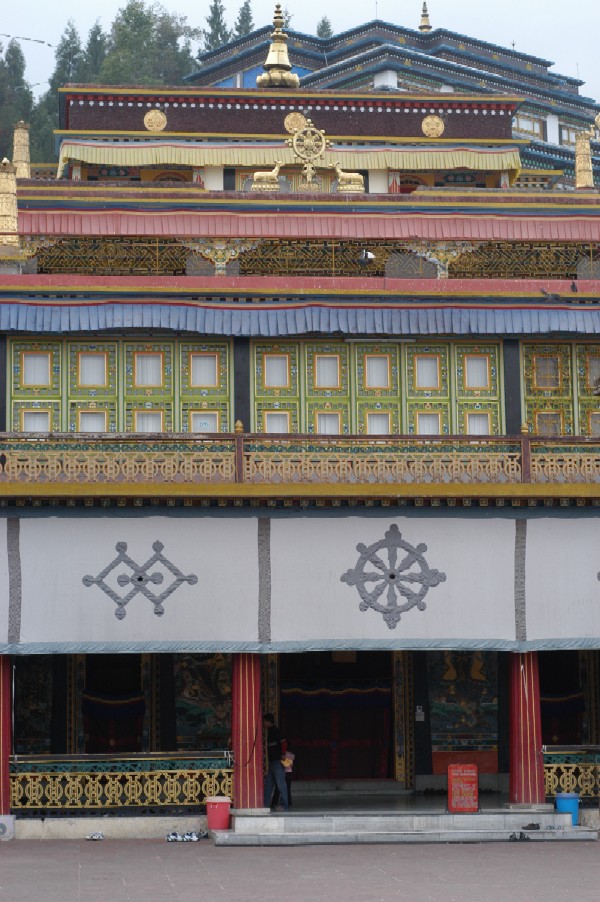 quite pleased with his little bit of authority. When a good shake or poke did rouse a sleeping monk he would reach over and pinch their ears which got an immediate reaction. Sometimes they grumbled at him or reached back to grab at him as he deftly scooted out of range with a bit smile on his face. quite pleased with his little bit of authority. When a good shake or poke did rouse a sleeping monk he would reach over and pinch their ears which got an immediate reaction. Sometimes they grumbled at him or reached back to grab at him as he deftly scooted out of range with a bit smile on his face.
Before the chanting ended we quietly took our leave and went to visit the rest of the monastery. In front of the main hall there were a couple of elderly nuns begging for alms. Their smiling bald faces were irresistible and Rob dipped into his pocked to give them something. Leaving the walled courtyard of the main hall we walked around the back of the monastery, passing the kitchen with a bright sign posted about the virtues of vegetarianism. At the back of the monastery was a small hall that housed the Golden Stupa, the reliquary that held the bones and ashes of the 16th Karmapa Lama. We quietly entered and were allowed to circumambulate the stupa and leave an offering before the monk closed of the inner sanctuary. Across from the hall there was a large building that was home to the Karma Shri Naland Institute of Buddhist Studies. It was laid out like a school building but on the top floor there was a large hall with altars. A small Indian group was making a tour of the monastery and we entered the hall with them. Being quiet wasn't really the method of worship for Hindus so this group sort of disturbed the atmosphere but I could see that they were genuinely interested in what they were seeing, even if they seemed to know very little about it. At least they were getting out and exploring the other cultures that populated their diverse country. were seeing, even if they seemed to know very little about it. At least they were getting out and exploring the other cultures that populated their diverse country.
Next to the institute we found a trail leading up the back hill of the monastery. It gave us a great view out over the complex which was engulfed in misty, very ethereal. Before leaving we went back into the main courtyard and visited a small Tara Prayer Room that was in a room on the second floor along the wall. A sign along the railing showed where it was but it proved a bit tricky to reach. Inside we found a lone monk sitting across from a wall of Tara statues and the main Tara altar. When I took refuge in Buddhism during my visit to Nepal, the name I was given was related to the Green Tara so I have always taken particular interest in her worship. The monk asked if we were Buddhists and then handed us a special tea mixture as well as a colored string to attach to our neck or arms, as a kind of blessing. Mine was red, for a Buddhist, and Rob's was yellow, for a non-Buddhist. We were soon joined by the three American women and the monk proceeded to explain about the Tara, the bodhisattva of compassion, and the altar. I watched as the young woman who had been meditating in the hall listened with wide-eyes. It seemed that Buddhism was still new to her but she had become a practitioner. It reminded me of myself when I was younger and had newly encountered the religion. It was a pivotal experience for me. I don't consider myself a practicing Buddhist but the mind-opening Buddhist 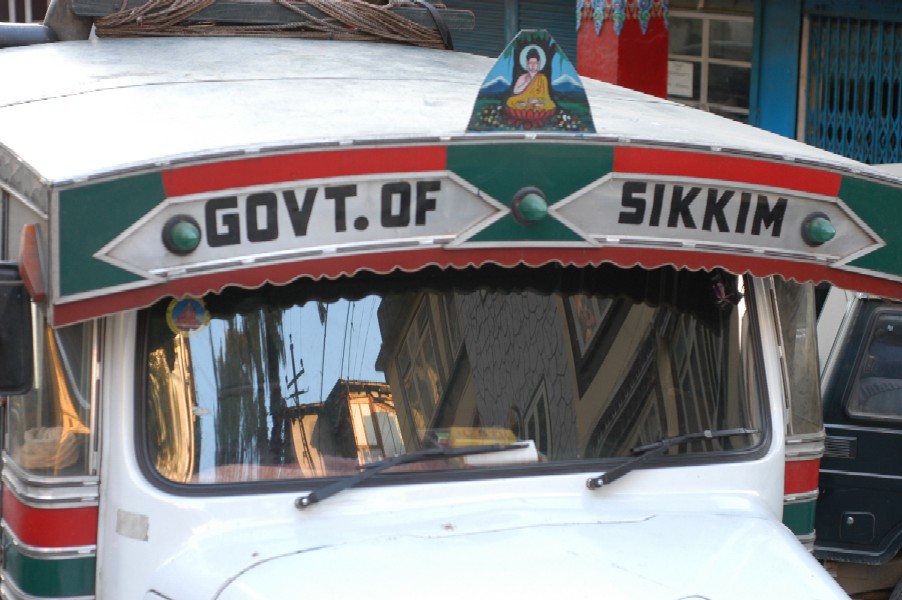 philosophy and certain aspects of the Buddhist way of life will always be part of me. philosophy and certain aspects of the Buddhist way of life will always be part of me.
Our driver was waiting patiently for us when we returned to the van. The drive back seemed to go quicker since the bumpier part of the road was on the Rumtek side and we got that over with first. We had grown tired of our Baker's Cafe and decided to have room service in our hotel so we could get packed up for the trip to Pelling.
December 22 - 23. GANGTOK (SIKKIM) I became sick in the night and threw up my dinner so it seemed like a bad idea to get on an all day jeep ride across Sikkim. Rob went over to the jeep station near the tram and tried to return our seats but they wouldn't give us a refund. Fortunately, a family of four happened along that needed four seats so they bought the tickets from Rob. I didn't get sick again but didn't feel well for the first part of the day so we didn't get new tickets for the following day, just in case. I am not sure what caused me to feel sick but I suspect it was our dinner. We'd eaten at the hotel before without any problems but the food we ate the night before tasted like they had used rancid oil. We were plenty tired of our hotel anyway and it wasn't just the bad meal. They also never came to clear the dishes, even when we called and called, and  they had done something foul to our laundry. The laundry service at Hotel Seven Seventeen in Darjeeling had been wonderful and always smelled so good. The laundry we'd had done at Hotel Golden Heights smelled like it had been dried over burning trash and that is probably what happened. We could smell it sometimes through the window in our room. I even tried to re-wash some of my things and I couldn't get the smell out. We complained but they just shrugged. There was one fantastic bellman that offered really good service, whenever he was on duty, but the others were pretty much slackers. The other annoyance we'd had was the periodic Indian guests on the floor below us. They tended to travel in groups and leave their doors open so they could yell back and forth and the kids ran all over the place, yelling and slamming doors. Even though they were on the floor below, a stairwell made of tile and concrete didn't help to buffer the noise. So, we were just really fed up with our hotel and, frankly, Gangtok. It wasn't a bad place but we'd just had enough of it. It was unfortunate that we ended up staying there another two days just because I got sick. they had done something foul to our laundry. The laundry service at Hotel Seven Seventeen in Darjeeling had been wonderful and always smelled so good. The laundry we'd had done at Hotel Golden Heights smelled like it had been dried over burning trash and that is probably what happened. We could smell it sometimes through the window in our room. I even tried to re-wash some of my things and I couldn't get the smell out. We complained but they just shrugged. There was one fantastic bellman that offered really good service, whenever he was on duty, but the others were pretty much slackers. The other annoyance we'd had was the periodic Indian guests on the floor below us. They tended to travel in groups and leave their doors open so they could yell back and forth and the kids ran all over the place, yelling and slamming doors. Even though they were on the floor below, a stairwell made of tile and concrete didn't help to buffer the noise. So, we were just really fed up with our hotel and, frankly, Gangtok. It wasn't a bad place but we'd just had enough of it. It was unfortunate that we ended up staying there another two days just because I got sick.
We spent a lot of time in our hotel room in those two days but never ate at the hotel again. We found some spectacular 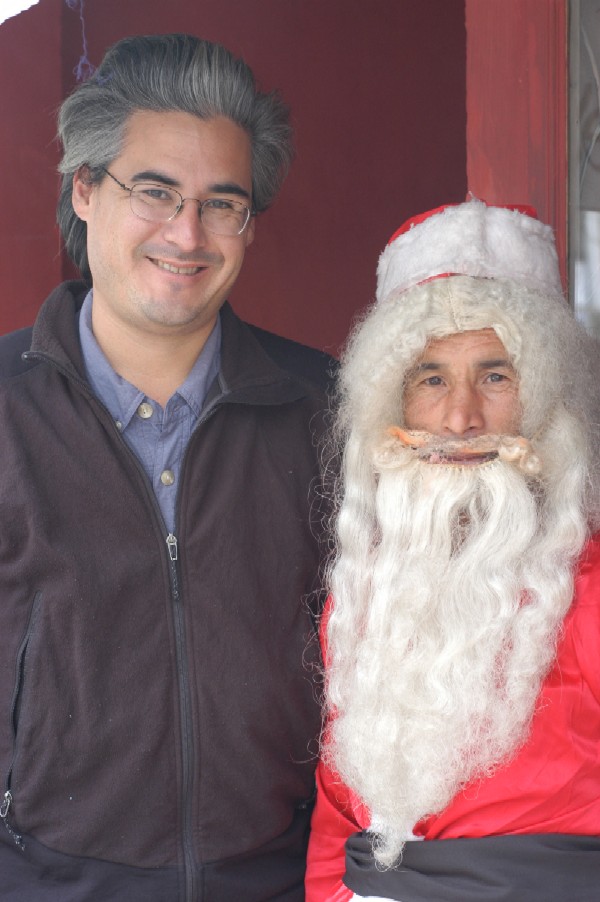 breakfasts at the Modern Central Lodge up on Tibet Road and tried out a new restaurant on PS Road called The Square. The Christmas spirit seemed to be kicking up in Gangtok and we found a skinny man dressed as Santa standing in front of a shop on MG Marg. We also put the extra time to use by getting some bank paperwork completed before the end of the year. What would have been a simple task at home became a small adventure in Gangtok. It meant searching out the post office, only to find out they didn't send international faxes. A small hole-in-the-wall across the street filled the gap with international phone and fax service. It all worked fine but took some running around. We sent a hard copy via express post just to make sure it got there okay. breakfasts at the Modern Central Lodge up on Tibet Road and tried out a new restaurant on PS Road called The Square. The Christmas spirit seemed to be kicking up in Gangtok and we found a skinny man dressed as Santa standing in front of a shop on MG Marg. We also put the extra time to use by getting some bank paperwork completed before the end of the year. What would have been a simple task at home became a small adventure in Gangtok. It meant searching out the post office, only to find out they didn't send international faxes. A small hole-in-the-wall across the street filled the gap with international phone and fax service. It all worked fine but took some running around. We sent a hard copy via express post just to make sure it got there okay. |
SRI LANKA
Colombo
Oct 25
Oct 26
Oct 27-29
Nuwara Eliya
Oct 30
Oct 31
Kandy
Nov 1-5 (1)
Nov 1-5 (II)
Polonnaruwa
Nov 6
Sigiriya & Dambulla
Nov 7
Colombo
Nov 8
INDIA
Ft.Cochin
Nov 9-15 (I)
Nov 9-15 (II)
Nov 16
Nov 17-18
Madurai
Nov 19
Nov 20
Tiruchirapalli
Nov 21
Nov 22
Nov 23
Chennai
Nov 24
Nov 25-26
Nov 27-28
Ft.Cochin
Nov 29
Lakshadweep
Nov 30-Dec 4 (I)
Nov 30-Dec 4 (II)
Trans-India Train
Dec 5-7 (I)
Dec 5-7 (II)
Siliguri
Dec 8
Darjeeling
Dec 9
Dec 10-13
Dec 14
Sikkim
Dec 15
Dec 16-20
Dec 21-23
Dec 24
Dec 25
Darjeeling
Dec 26
Dec 27-Jan 2
Siliguri
Jan 3
Jaigon
(Bhutan)
Jan 4
Kolkata
Jan 5-6
THAILAND
Bangkok
Jan 6-13 (I)
Jan 6-13 (II)
Jan 6-13 (III)
|

